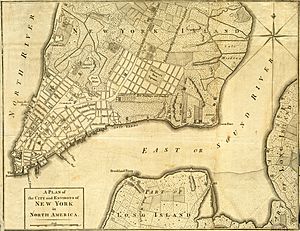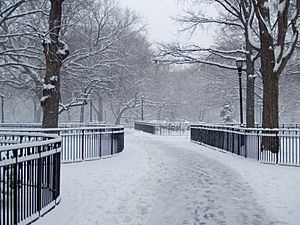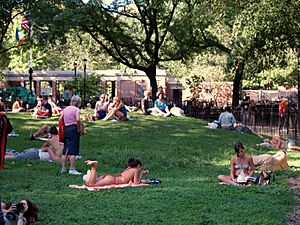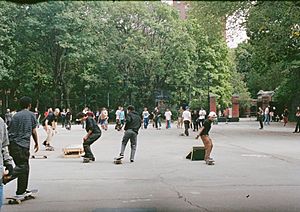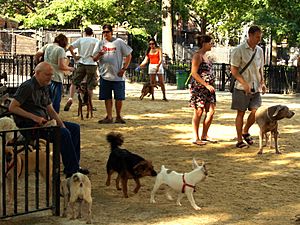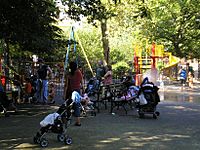Tompkins Square Park facts for kids
Quick facts for kids Tompkins Square Park |
|
|---|---|
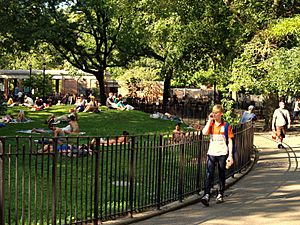
The park's entrance is at East 7th and Avenue A
|
|
| Type | public |
| Location | Alphabet City/East Village, Manhattan, New York City |
| Area | 10.5 acres (4.2 ha) |
| Created | 1834 |
| Operated by | New York City Department of Parks and Recreation |
| Open | 6 a.m. to 1 a.m. |
| Status | Open all year |
Tompkins Square Park is a large public park in the East Village area of Manhattan, New York City. It covers about 10.5-acre (4.2 ha) of land. The park is shaped like a square. It is bordered by East 10th Street to the north, Avenue B to the east, East 7th Street to the south, and Avenue A to the west. St. Marks Place is also nearby. The park first opened in 1834. It is named after Daniel D. Tompkins, who was a Vice President of the United States.
Park History
How Tompkins Square Park Began
Tompkins Square Park is built on land that used to be a salt marsh and open meadows. These were called "Stuyvesant meadows." They were the largest natural wetlands on Manhattan island. Over time, this land was filled in.
The Stuyvesant family owned this land. They inherited it from Peter Stuyvesant, who received it in the 1600s. The land was not taxed much because it was mostly farmland. The city leaders wanted to increase tax money. So, in 1829, Peter Gerard Stuyvesant gave some land to the city. He wanted it to remain a public space. The city paid other owners $62,000 to create a residential square. It cost another $22,000 to prepare the muddy site. Tompkins Square Park finally opened in 1834.
The park was surrounded by a cast-iron fence in 1835. Trees were planted, and people hoped the area would become wealthy. However, the Panic of 1837 stopped the city's growth.
Naming the Park
The park is named after Daniel D. Tompkins (1774–1825). He was the Vice President of the United States under President James Monroe. He also served as the Governor of New York from 1807 to 1817. Tompkins had helped drain some of the wet land in the area for small forts during the War of 1812. The park officially opened in 1850.
Protests and Conflicts
Tompkins Square Park has a long history of protests.
- In 1857, immigrants protested because they had no jobs and not enough food. Police attacked them.
- In 1863, the deadly Draft Riots happened in the park.
- On January 13, 1874, the Tompkins Square Riot took place. Police stopped a large protest of thousands of workers. This riot showed a new time of labor conflicts. It happened during the Panic of 1873, a time of economic hardship. Workers wanted the government to create public works programs to provide jobs.
- In 1877, five thousand people fought with the National Guard. They had gathered to hear speeches from Communist leaders.
- On April 7, 1897, a rabbi was arrested. He did not have a permit for a Jewish ritual called Birkat Hachama. This ritual is performed only once every 28 years.
20th Century Changes
In the mid-1800s, the "Square" had a large area for the New York National Guard to train. The park's current design was created by Robert Moses in 1936. Some say it was designed to help control large crowds that had gathered there for protests since the 1870s. This tradition of protest continued. The park became a place for demonstrations against the Vietnam War in the 1960s.
By the 1980s, Tompkins Square Park was known for the city's growing social problems.
In August 1988, a riot happened in the park. Police tried to remove homeless people from the park. Thirty-eight people were hurt. People watching and homeless individuals were caught in the police action. This happened on the night of August 6 and early morning of August 7. Police surrounded the park and charged at the crowd. They also told people not to walk on nearby streets. Much of the violence was recorded on video. These videos were shown on local TV news. Even though videos showed police actions, no officers were found guilty. A punk rock festival is now held in the park each year to remember this event.
More clashes happened during May Day celebrations in 1990. This was at the end of a "Resist 2 Exist" Festival. Twenty-nine protesters were arrested. Twenty-five were charged with serious crimes. These charges were dropped for everyone except Kenny Toglia. He spent a year in jail for a minor charge. These events are shown in the film Your House is Mine (2004).
From June 3, 1991, to July 25, 1992, the park was closed for repairs. This also helped to keep out homeless people and calm tensions. The Tompkins Square Park Bandshell was one of the first things to be fixed.
Tompkins Square Park Today
The gentrification of the East Village in the 1990s and 2000s changed Tompkins Square Park. The park now has a curfew, and homeless people are not allowed to stay there. The park was closed and renovated in 1991 and reopened in 1992.
Today, the park is a popular spot. It has playgrounds, basketball courts, a dog run, a ping pong table, handball courts, and outdoor chess tables. It attracts young families, students, seniors, and tourists. Since the 1980s, the asphalt courts have been used as a skatepark for many generations of skateboarders.
Park Events
Tompkins Square Park hosts several events:
- The outdoor drag festival Wigstock used to be held here. It is now part of the Howl Festival.
- The Charlie Parker Jazz Festival is a music event. It honors Charlie Parker, a famous jazz musician who lived nearby.
- The New Village Music Festival started in 2007. It celebrates New York's diverse music scene. It also shows how important music and cultural arts programs are.
- There is an annual event in early August. It remembers the 1988 Police Riot and features local bands.
- The Food Not Bombs Manhattan group serves food every Sunday in the park.
- The French Embassy and the New York City Department of Parks and Recreation host a free outdoor French film festival. Critically acclaimed French films are shown each Friday at sunset in city parks, including Tompkins, during June and July.
Park Nature
American Elm Trees
One special feature of Tompkins Square Park is its many old American Elm trees. One elm tree in the park's center is very important to followers of the Hare Krishna religion. On October 9, 1966, A. C. Bhaktivedanta Swami Prabhupada, who started the International Society for Krishna Consciousness, held the first outdoor chanting of the Hare Krishna mantra outside of India. The Beat poet Allen Ginsberg was there. This event is seen as the start of the Hare Krishna religion in the United States. The tree is considered a very important religious site.
American elm trees are known for their tall, wide canopies. They provide lots of shade in spring, summer, and fall. It is rare to find so many American elms today. Many have been killed by Dutch Elm Disease. This disease is caused by a fungus carried by elm bark beetles. It spread across the United States in the 1930s. It is still a threat to the park's elm trees. The park has lost at least 34 trees to the disease. But Tompkins Square Park still has many elms that people enjoy. The East Village Parks Conservancy, a volunteer group, raises money to care for these historic trees.
Park Activities
Playgrounds
The main playground is closest to Avenue A. It has jungle gyms, rock climbing areas, and a water fountain. There is also a large sandbox, swings, and benches. Two smaller playgrounds are near 7th Street and Avenue B. The main playground was renovated and reopened in August 2009.
Multi-Purpose Courts
Skateboarding Training Facility
Since the 1980s, the asphalt courts at Tompkins Square Park have been a popular skatepark. Many generations of skateboarders have trained here. In 1989, Shut Skateboards held a contest at the park with ramps and other obstacles. The asphalt courts are known as T.F. or "training facility." Many famous skateboarders have skated at Tompkins Square Park. These include Tyshawn Jones, Alex Olson, Yaje Popson, Jarrod Brandreth, Harold Hunter, Ted Barrow, Andy Kessler, Zered Bassett, and Jake Johnson.
Tompkins Square Dog Run
The Tompkins Square Dog Run was the first dog run in New York City. It opened in 1990 as part of a big renovation of the park. It recently had a $450,000 renovation. Much of the money came from the New York City government and from dog run users. It now has a crushed stone surface, three swimming pools for dogs, a tree deck, and bath areas with hoses to wash pets.
The dog run hosts the Annual Tompkins Square Halloween Dog Parade. This event raises money to help maintain the run. It is the biggest dog Halloween party in the United States. More than 400 dogs in costume and 2,000 people attend each year.
Park Monuments
The park has three monuments.
- There is a monument on the north side of the park. It remembers the General Slocum boating disaster. This happened on June 15, 1904. Over a thousand people drowned in the East River. Most were German immigrant mothers and children. This was the biggest loss of life in New York City before the September 11, 2001 attacks. The area near the park was called Kleindeutschland. After the disaster, many German families moved away. This event is also mentioned in James Joyce's novel Ulysses.
- The park also has an elm tree in the southern plaza. This tree is important to the Hare Krishna faith. In 1966, Indian Sadhu A. C. Bhaktivedanta Swami Prabhupada sang and preached under this tree. This started the worldwide Hare Krishna movement. A New York City Department of Parks and Recreation plaque notes that the tree is sacred.
- In the southeast corner of the park, there is a statue of Samuel S. Cox (1824–1889). He was a politician from New York City. He served in the U.S. House of Representatives and as a U.S. Minister to the Ottoman Empire.
- The Temperance Fountain is near Avenue A, south of 9th Street. It was built in 1888 during the temperance movement. This movement encouraged people not to drink alcohol. The fountain gave people free, clean drinking water. This way, they would not need to drink alcohol to quench their thirst. The fountain was a gift from Henry D. Cogswell, a wealthy dentist and temperance supporter. The fountain is a square granite structure. It has four stone columns that hold up a canopy. On the sides of the canopy, the words "Faith," "Hope," "Charity," and "Temperance" are carved. On top of the canopy is the Greek goddess Hebe, who was the cupbearer to the gods on Mount Olympus.
See also
 In Spanish: Tompkins Square Park para niños
In Spanish: Tompkins Square Park para niños


